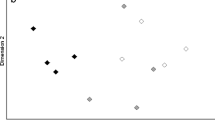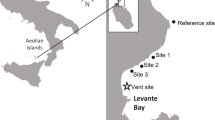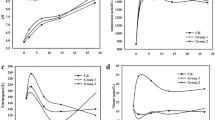Abstract
Nitrogen fixation is the primary N source in the highly productive but N-limited North Inlet, SC, USA salt marsh system. The diverse assemblages of nitrogen-fixing (diazotrophic) bacteria associated with the rhizospheres of the short and tall growth forms of Spartina alterniflora were analyzed at two sites, Crab Haul Creek and Goat Island, which are in different tidal creek drainage systems in this marsh. The sites differed in proximity to the main channel for tidal intrusion and in several edaphic parameters. We hypothesized that either the differing abiotic environmental regimes of the two sites or the variation due to seasonal effects result in differences in the diazotroph assemblage. Rhizosphere samples were collected seasonally during 1999 and 2000. DNA was purified and nifH amplified for denaturing gradient gel electrophoresis (DGGE) analysis of diazotroph assemblage composition. Principal components analysis was used to analyze the binary DGGE band position data. Season strongly influenced assemblage composition and biplots were used to identify bands that significantly affected the seasonal and site-specific clustering. The types of organisms that were most responsive to seasonal or site variability were identified on the basis of DGGE band sequences. Seasonally responsive members of the anaerobic diazotrophs were detected during the winter and postsenescence conditions and may have been responsible for elevated pore water sulfide concentrations. Sequences from a diverse assemblage of Gammaproteobacteria were predominant during growth periods of S. alterniflora. Abiotic environmental parameters strongly influenced both the S. alterniflora and the diazotrophic bacterial assemblages associated with this keystone salt marsh plant species.




Similar content being viewed by others
References
Bagwell CE, Lovell CR (2000) Persistence of selected Spartina alterniflora rhizoplane diazotrophs exposed to natural and manipulated environmental variability. Appl Environ Microbiol 66:4625–4633
Bagwell CE, Piceno YM, Ashburn-Lucas A, Lovell CR (1998) Physiological diversity of the rhizosphere diazotroph assemblages of selected salt marsh grasses. Appl Environ Microbiol 64:4276–4282
Belle W (2009) Baruch Institute long term meteorological data. http://links.baruch.sc.edu/Data/LongTermData.html
Blood ER, Vernberg FJ (1992) Characterization of the physical, chemical, and biological conditions and trends in Winyah Bay and North Inlet estuaries: 1970–1985. In: Characterization of the physical, chemical, and biological conditions and trends in three South Carolina Estuaries. Winyah Bay and North Inlet Estuaries, vol. II. SC Sea Grant Consortium, Charleston, 162 pp
Bradley PM, Morris JT (1991) The influence of salinity on the kinetics of NH +4 uptake in Spartina alterniflora. Oecologia 85:375–380
Brown M, Friez M, Lovell CR (2003) Expression of nifH genes by diazotrophic bacteria in the rhizosphere of short form Spartina alterniflora. FEMS Microbiol Ecol 43:411–417
Brown DM, Lin PKT (1991) Synthesis and duplex stability of oligonucleotides containing adenine–guanine analogues. Carbohydrate Res 216:129–139
Colwell RR (ed) (1984) Vibrios in the environment. New York, Wiley 634 pp
Dai T, Wiegert RG (1997) A field study of photosynthetic capacity and its response to nitrogen fertilization in Spartina alterniflora. Est Coast Shelf Sci 45:273–283
Dame RF (1989) The importance of Spartina alterniflora to Atlantic coast estuaries. Crit Rev Aq Sci 1:639–660
Dame R, Chrzanowski T, Bildstein K, Kjerve B, McKellar H, Nelson D, Spurrier J, Stancyk S, Stevenson H, Vernberg J, Zingmark R (1986) The outwelling hypothesis and North Inlet, South Carolina. Mar Ecol Prog Ser 33:217–229
Dame RF, Kenny PD (1986) Variability of Spartina alterniflora primary production in the euhaline North Inlet estuary. Mar Ecol Prog Ser 32:71–80
Fromin N, Hamelin J, Tarnawski S, Roesti S, Jourdain-Miserez K, Forestier N, Teyssier-Cuvelle S, Gillet F, Aragno M, Rossi P (2002) Statistical analysis of denaturing gel electrophoresis (DGE) fingerprinting patters. Environ Microbiol 4:634–643
Gandy EL, Yoch DC (1988) Relationships between nitrogen-fixing sulfate reducers and fermenters in salt marsh sediments and roots of Spartina alterniflora. Appl Environ Microbiol 54:2031–2036
Hansen HP, Grasshoff K (1983) Automated chemical analysis. In: Grasshoff K, Ehrhardt M, Kremling K (eds) Methods of seawater analysis, 2nd edn. Chemie, Deerfield Beach, pp 347–395
Herbert RA (1975) Heterotrophic nitrogen fixation in shallow estuarine sediments. J Expt Mar Biol Ecol 12:215–225
Hopkinson CS, Schubauer JP (1984) Static and dynamic aspects of nitrogen cycling in the salt marsh graminoid Spartina alterniflora. Ecology 65:961–969
Howarth RW, Giblin A (1983) Sulfate reduction in the salt marshes at Sapelo Island, Georgia. Limnol Oceanogr 28:70–82
Jofre E, Rivarola V, Balegno H, Mori G (1998) Differential gene expression by Azospirillum brasilense Cd under saline stress. Can J Microbiol 44:929–936
Jones K (1974) Nitrogen fixation in a salt marsh. J Ecol 62:553–565
Jurgens K, Pernthaler J, Schalla S, Amann R (1999) Morphological and compositional changes in a planktonic bacterial community in response to enhanced protozoan grazing. Appl Environ Microbiol 65:1241–1250
King GM, Klug MJ, Wiegert RG, Chalmers AJ (1982) Relation of soil water movement and sulfide concentration to Spartina alterniflora production in a Georgia salt marsh. Science 218:61–63
Koretsky CM, Moore CM, Lowe KL, Meile C, Dichristina TJ, Van Cappellen P (2003) Seasonal oscillation of microbial iron and sulfate reduction in salt marsh sediments (Sapelo Island, GA, USA). Biogeochemistry 64:179–203
Krone RB (1985) Simulation of marsh growth under rising sea levels. In: Waldrop WR (ed) Hydraulics and hydrology in the small computer age. Hydraulics Division, ASCE, Reston, Virginia, pp 106–115
Kumar S, Tamura K, Nei M (2004) MEGA3: integrated software for molecular evolutionary genetics analysis and sequence alignment. Brief Bioinform 5:150–163
LaRocque JR, Bergholz PW, Bagwell CE, Lovell CR (2004) Influence of host plant-derived and abiotic environmental parameters on the composition of the diazotroph assemblage associated with roots of Juncus roemerianus. Anton Leeuw Int J G 86:249–261
Lin PKT, Brown DM (1989) Synthesis and duplex stability of oligonucleotides containing cytosine–thymine analogues. Nucleic Acids Res 17:10373–10383
Lindstrom ES (1998) Bacterioplankton community composition in a boreal forest lake. FEMS Microbiol Ecol 27:163–174
Livingstone DC, Patriquin DG (1980) Nitrogenase activity in relation to season, carbohydrates and organic acids in a temperate zone root association. Soil Biol Biochem 12:543–546
Lovell CR (2005) Belowground interactions among salt marsh plants and microorganisms. In: Kristensen E, Kostka JE, Hease RH (eds) Interactions between macro- and microorganisms in marine sediments. Coastal and estuarine studies, vol 60. American Geophysical Union, Washington, pp 61–83
Lovell CR, Bagwell CE, Czako M, Marton L, Piceno YM, Ringelberg DB (2001) Stability of a rhizosphere microbial community exposed to natural and manipulated environmental variability. FEMS Microbiol Ecol 38:69–76
Lovell CR, Decker PV, Bagwell CE, Friez M, Matsui GY (2008) Analysis of a diverse assemblage of diazotrophic bacteria from Spartina alterniflora using DGGE and clone library screening. J Microbiol Methods 73:160–171
Lovell CR, Friez MJ, Longshore JW, Bagwell CE (2001) Recovery and phylogenetic analysis of nifH sequences from diazotrophic bacteria associated with dead aboveground biomass of Spartina alterniflora. Appl Environ Microbiol 67:5308–5314
Lovell CR, Piceno YM (1994) Purification of DNA from estuarine sediments. J Microbiol Methods 20:161–174
Lovell CR, Piceno YM, Quattro JM, Bagwell CE (2000) Molecular analysis of diazotroph diversity in the rhizosphere of the smooth cordgrass, Spartina alterniflora. Appl Environ Microbiol 66:3814–3822
Marinucci AC, Hobbie JE, Helfrich JVK (1983) Effect of litter nitrogen on decomposition and microbial biomass in Spartina alterniflora. Microb Ecol 9:27–40
McClung CR, van Burkum P, Davis RE, Sloger C (1983) Enumeration and localization of N2-fixing bacteria associated with roots of Spartina alterniflora Loisel. Appl Environ Microbiol 45:1914–1920
Morris JT (1988) Pathways and controls of the carbon cycle in salt marshes. In: Hook DD, McKee WH Jr, Smith HK, Gregory J, Burrell VG Jr, DeVoe MR, Sojka RE, Gilbert S, Banks R, Stolzy LH, Brooks C, Matthews TD, Shear TH (eds) The ecology and management of wetlands. Volume I: ecology of wetlands. Croom Helm, London, England. Timber, Portland, pp 497–510
Morris JT (1991) Effects of nitrogen loading on wetland ecosystems with particular reference to atmospheric deposition. Ann Rev Ecol Syst 22:257–279
Morris JT, Haskin B (1990) A 5-yr record of aerial primary production and stand characteristics of Spartina alterniflora. Ecology 7:2209–2217
Morris JT, Porter D, Neet M, Noble PA, Schmidt L, Lapine LA, Jensen JR (2005) Integrating LIDAR elevation data, multi-spectral imagery and neural network modeling for marsh characterization. Int J Remote Sens 26:5221–5234
Patriquin DG (1978) Nitrogen fixation (acetylene reduction) associated with cord grass Spartina alterniflora Loisel. Ecol Bull 26:20–27
Patriquin DG, Keddy C (1978) Nitrogenase activity (acetylene reduction) in a Nova Scotia salt marsh: its association with angiosperms and the influence of some edaphic factors. Aq Bot 4:227–244
Pernthaler J, Glockner FO, Unterholzner S, Alfreider A, Psenner R, Amann R (1998) Seasonal community and population dynamics of pelagic bacteria and archaea in a high mountain lake. Appl Environ Microbiol 64:4299–4306
Piceno YM, Lovell CR (2000) Stability in natural bacterial communities: I. Nutrient addition effects on rhizosphere diazotroph assemblage composition. Microb Ecol 39:32–40
Piceno YM, Lovell CR (2000) Stability in natural bacterial communities: II. Plant resource allocation effects on rhizosphere diazotroph assemblage composition. Microb Ecol 39:41–48
Piceno YM, Noble PA, Lovell CR (1999) Spatial and temporal assessment of diazotroph assemblage composition in vegetated salt marsh sediments using denaturing gradient gel electrophoresis analysis. Microb Ecol 38:157–167
Schubauer JP, Hopkinson CS (1984) Above and belowground emergent macrophyte production and turnover in a coastal marsh ecosystem, Georgia. Limnol Oceanogr 29:1052–1065
Seliskar DM, Gallagher JL, Burdick DM, Mutz LM (2002) The regulation of ecosystem functions by ecotypic variation in the dominant plant: a Spartina alterniflora salt marsh case study. J Ecol 90:1–11
Teal JM, Valiela I, Berlo D (1979) Nitrogen fixation and rhizosphere and free-living bacteria in a salt marsh. Limnol Oceanogr 24:126–132
Truper HG, Schlegel HG (1964) Sulfur metabolism in Thiorhodaceae: I. Quantitative measurements on growing cells of Chromatium okenii. Anton Leeuw Int J G 30:225–238
Turner RE (1976) Geographic variations in salt marsh macrophyte production: a review. Contrib Mar Sci 20:47–68
Valiela L, Teal JM (1974) Nutrient limitation in salt marsh vegetation. In: Riemold RJ, Queen WH (eds) Ecology of halophytes. Academic, New York, pp 547–563
Van Bastelaure E, De Mot R, Michiels K, Vanderleyden J (1993) Differential gene expression in Azospirillum spp. by plant root exudates: analysis of protein profiles by two dimensional polyacrylamide gel electrophoresis. FEMS Microbial Lett 112:335–342
Whiting GJ, Gandy EL, Yoch DC (1986) Tight coupling of root-associated nitrogen fixation and plant photosynthesis in the salt marsh grass Spartina alterniflora and carbon dioxide enhancement of nitrogenase activity. Appl Environ Microbiol 52:108–113
Whiting GJ, Morris JT (1986) Nitrogen fixation (C2H2 reduction) in a salt marsh: its relationship to temperature and an evaluation of an in situ chamber technique. Soil Biol Biochem 18:515–521
Yoch DC, Whiting GJ (1986) Evidence for NH4+ switch-off regulation of nitrogenase activity by bacteria in salt marsh sediments and roots of the grass Spartina alterniflora. Appl Environ Microbiol 51:143–149
Acknowledgements
We acknowledge the Belle W. Baruch Institute for Coastal and Marine Sciences for access to sampling sites and for logistical support and Mike Friez for assistance with DNA sequencing. This research was supported by the National Science Foundation awards DEB-0108412 and MCB-0237854 to C.R.L. Contribution 1578 to the Belle W. Baruch Institute for Coastal and Marine Sciences.
Author information
Authors and Affiliations
Corresponding author
Electronic supplementary material
Below is the link to the electronic supplementary material.
Supplementary Figure 1
Phylogenetic analysis of all bands from band stab analysis (nucleotide sequences, neighbor joining, 1,000 bootstrap replicates, Jukes Cantor correction and complete deletion of gaps and missing data) (GIF 1.27 mb)
Supplementary Figure 2
DGGE gel image representing September short- and tall-form Goat Island samples (GIF 621 kb)
Rights and permissions
About this article
Cite this article
Gamble, M.D., Bagwell, C.E., LaRocque, J. et al. Seasonal Variability of Diazotroph Assemblages Associated with the Rhizosphere of the Salt Marsh Cordgrass, Spartina alterniflora . Microb Ecol 59, 253–265 (2010). https://doi.org/10.1007/s00248-009-9558-0
Received:
Accepted:
Published:
Issue Date:
DOI: https://doi.org/10.1007/s00248-009-9558-0




